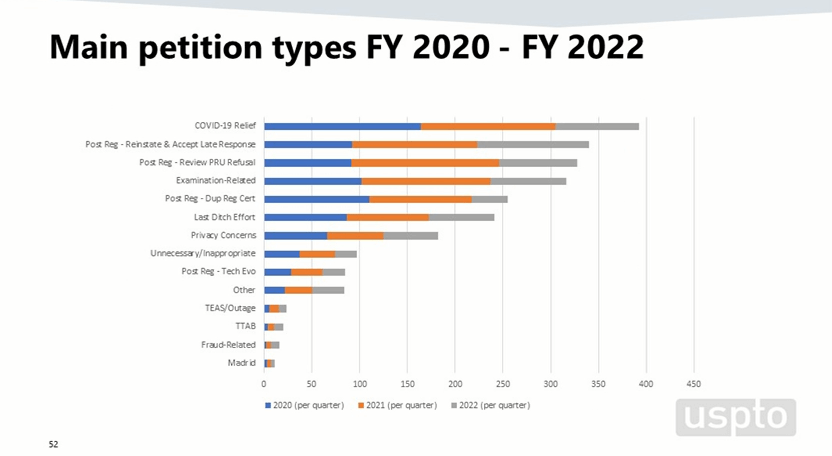USPTO UpdateTrademark Public Advisory Committee (TPAC) Quarterly Meeting
Nehal Madhani | August 02, 2022
On July 23, 2022, the USPTO held the Trademark Public Advisory Committee (TPAC) Quarterly Meeting, reviewing policies, goals, performance, budget, and user fees, among other important topics. This article provides a summary of key highlights from the meeting. Check out our summary of the last TPAC meeting: Q2 2022 TPAC Quarterly Meeting.
Trademarks Management Report
David Gooder, Commissioner for Trademarks, delivered the trademarks management report. He began by discussing trademark application filing levels. With the exception of FY2021, where filings were abnormally high, trademark filings are on track over the past several years. While FY2022 is down from 2021, that is not unexpected because the increase in 2021 was so dramatic. Filings in FY2022 are up 8% over FY2020 which is very healthy growth. One phenomenon that the USPTO is seeing in FY2022 is that since March-April, filings are starting to moderate as a result of what’s happening with the economy. As a result, filings are currently slightly down more than what is typically expected at this time of year. By the next TPAC meeting in November, the USPTO will have a better sense of how the filing numbers in March-April impacted overall filings for the year.
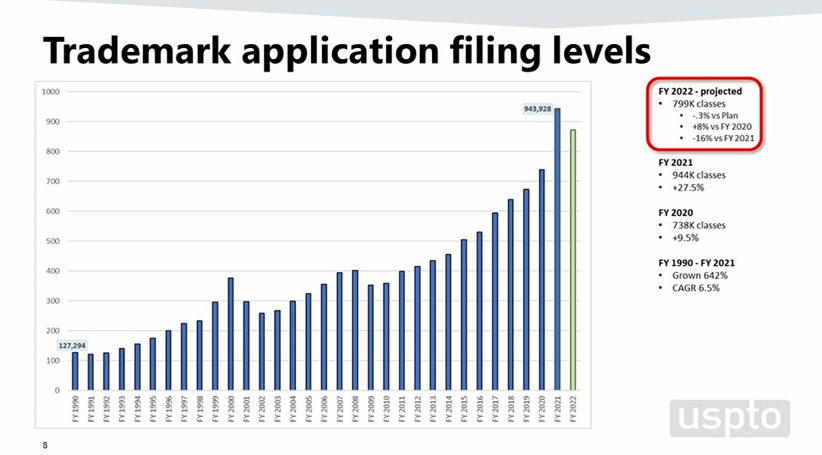
In terms of where new trademark filings are originating, thus far in FY2022, about 64% of filings are coming from applicants domiciled in the US. The USPTO is seeing a higher number of domestically-originated filings in FY2022 than in FY2021. This is because the number of Chinese applicants had risen so significantly in FY2021. Now, China makes up about 16% of filings YTD. This is much more in line with the normal growth pattern from filers based in China.
Also of note, Europe, while a smaller base, is growing. In general, growth in the European economy would correlate with an increase in US trademark applications from European organizations and individuals. Commissioner Gooder noted this general correlation between economic prosperity and trademark filings is true for other regions, including Asia and the Americas. The number of trademark filings from those regions is also increasing.
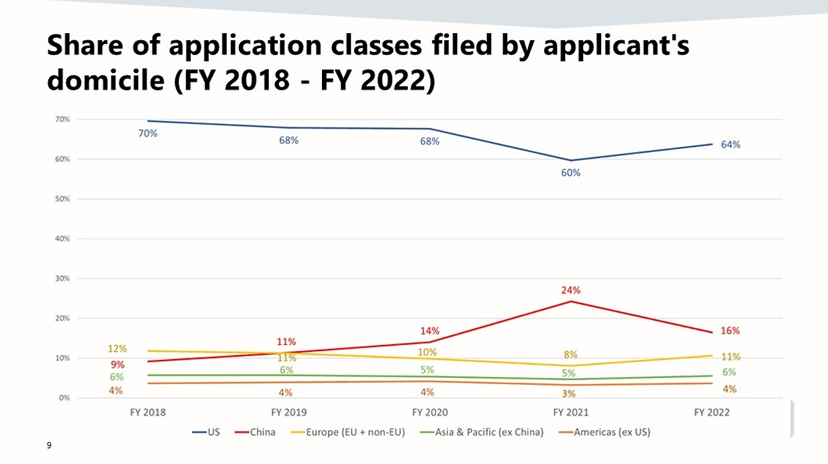
Next, Commissioner Gooder discussed trademark staffing. Trademark staffing now exceeds 1,000 employees (716 of which are examining attorneys). There is very low attrition overall among trademark staffing. David announced that there will be significant growth in new examining attorneys throughout 2022 and 2023.
Commissioner Gooder also discussed the USPTO’s flexibility and success with teleworking. 2022 marks the USPTO’s 25th year of teleworking. The USPTO was the first sub-agency of the government to begin teleworking. When the COVID-19 pandemic hit, it was very easy for the USPTO to transition to teleworking. Currently, almost 90% of full-time USPTO employees are teleworking. This allows people to live and work where they want, and this also enables the USPTO to expand the geographic diversity of people working at the USPTO. The chart below shows the geographic distribution of USPTO employees. There is a heavy concentration of people in the DC area, and the USPTO would like to work on expanding to other areas of the country.
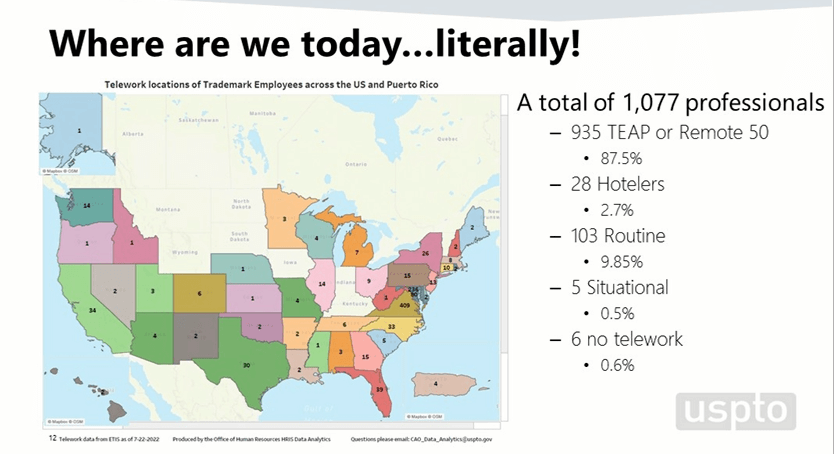
Financial Management Update
Sean Mildrew, Deputy Chief Financial Officer, provided a financial management update. The USPTO projects it will collect more than its appropriated levels and patent and trademark fees will be deposited into the reserve fund. The USPTO estimates it will end FY2022 with about $193 million in the reserve (the highest level it has been in 5 years) which is well-above the $120 million minimum . This is very good because the future is uncertain and it helps the USPTO maintain its operations and fulfill its mission.
Trademark Examination Policy Update
Amy Cotton, Deputy Commissioner for Trademark Examination Policy, delivered the trademark examination policy update. She began by giving an update on USPTO register protection initiatives. Commissioner Cotton explained that the USPTO is developing a series of access controls, essentially building a fence around the filing system to ensure that bad actors stay out. Phase 1, requiring customer accounts, is complete. This allows the USPTO to know who is behind the account and how many people are behind the account. Phase 2, requiring ID verification, is in progress. The deadline for mandatory ID verification is August 6, 2022. This phase allows the USPTO to hold bad actors accountable and also allows the USPTO to take down and keep down accounts that made fraudulent filings. Phase 3, requiring role-based accounts, was initially slated for 2023 but will likely move into 2024. User roles are significant because there are rules around each user role and the actions they are allowed to perform before the USPTO. The USPTO held a webinar on the topic to discuss roles in depth.
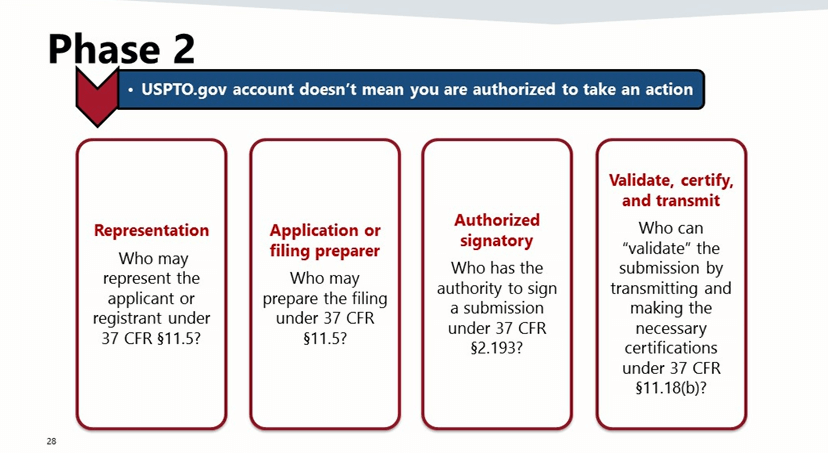
The next part of Commissioner Cotton’s discussion focused on Petitions to the Director. Commissioner Cotton noted that the team managing the petitions and Letters of Protest is made up of a managing attorney and supervisory attorneys, along with about 28 attorney advisors and paralegals. The group has been so inundated with work that the call line was recently re-routed to the Trademark Assistance Center. To help with the growth, 11 petitions attorneys have been recently hired to help.
Commissioner Cotton shared details about how the petitions and Letters of Protest have increased over time.
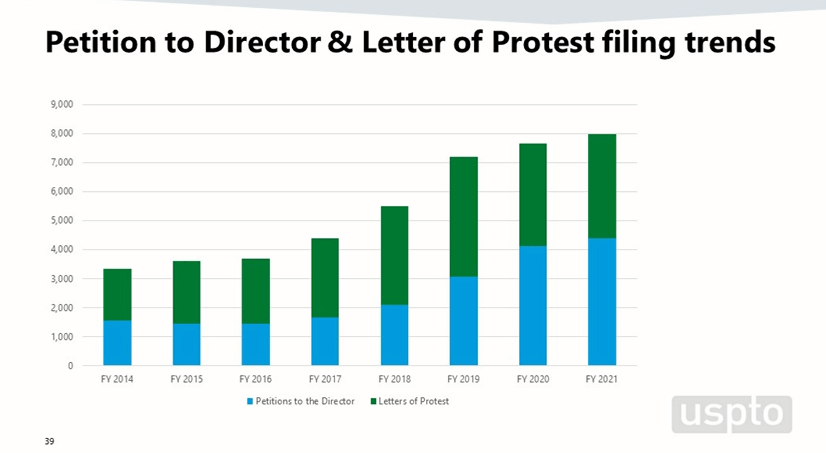
One of the responsibilities for this team is to review Letters of Protest and decide whether to pass the evidence on to examiners. Commissioner Cotton indicated that both the USPTO and customers are seeing benefits from Letters of Protest. She explained that it is helpful to bring third party evidence before the USPTO that is relevant to an application without having to go through an opposition before the TTAB. Letters of Protest are also helpful to examining attorneys because they bring forth evidence that improves the quality of the examination.
Commissioner Cotton presented a chart showing the increase in Letter of Protest filings over time, correlating with the increase in trademark application filings over time. In particular, Commissioner Cotton highlighted the increase in Letter of Protest filings in 2019 and its correlation with the rise in trademark application filings at the time. Also, Commissioner Cotton indicated that the implementation of the Trademark Modernization Act in 2020 helped to raise the profile of Letters of Protest because the TMA codified the Letter of Protest procedure. Additionally, Commissioner Cotton noted that the fee increases for oppositions in 2021 made Letters of Protest more attractive.
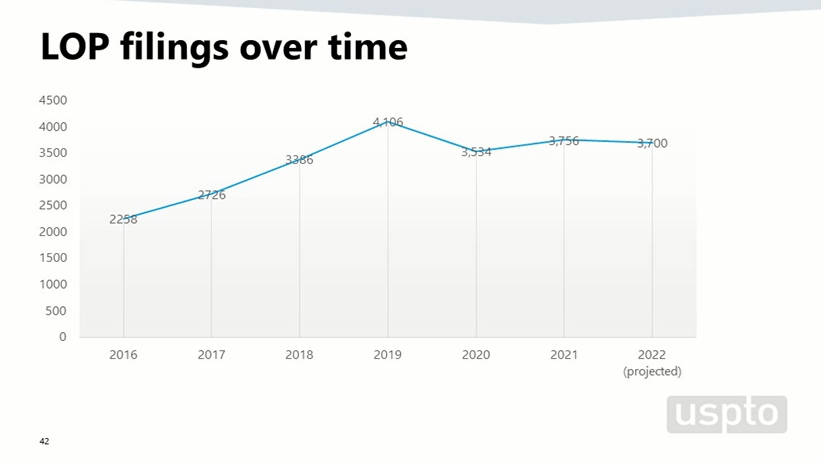
Next, Commissioner Cotton discussed the relative success of pre- and post-publication Letters of Protest. The timing of when a Letter of Protest is filed is significant because there are differences with the standards for consideration. Pre-publication Letters of Protest will be considered if the evidence is relevant for the grounds of dismissal. On the other hand, a post-publication Letter of Protest will be considered if the evidence establishes a prima facie case for refusal. The level of proof required is higher for a post-publication Letter of Protest. For more information on Letters of Protest, check out these Alt Legal blog articles:
- Letters of Protest: Practical Tips for Filing a Successful LOP
- Letters of Protest: Provide Convincing Evidence for Successful LOPs
Commissioner Cotton explained that if the petitions staff reviews a Letter of Protest and determines it is relevant, the petition is “considered.” The below charts show the number of pre-publication Letters of Protest and post-publication Letters of Protest considered over time. The chart shows that pre-publication Letters of Protest are considered much more frequently than post-publication Letters of Protest as the post-publication Letters of Protest demand a higher standard of proof that is difficult to meet.
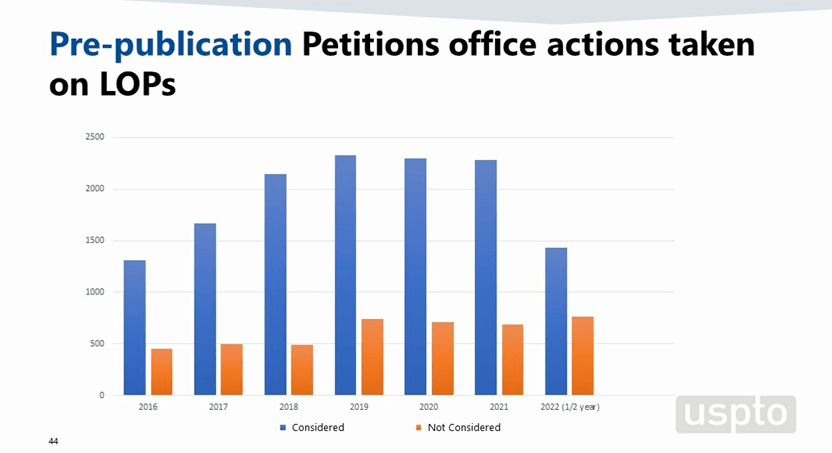
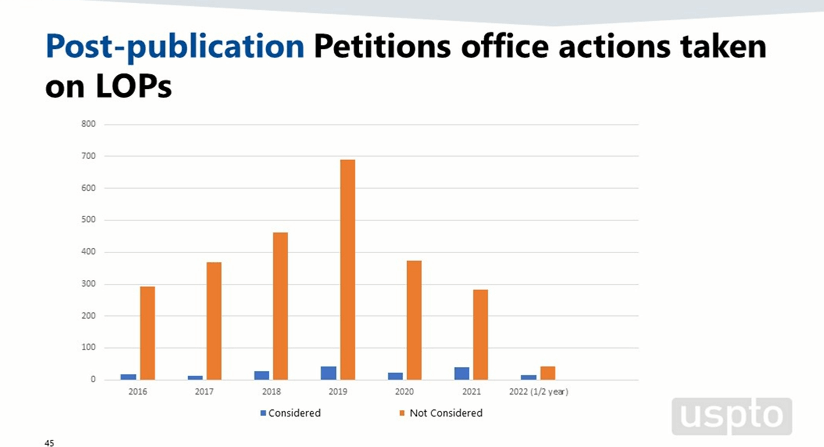
In terms of what the petitions team did with the evidence submitted through Letters of Protest, the below chart shows where the team declined to do anything with the evidence submitted (orange) and where the team chose to take action (blue). There are more instances where the team decided not to take action on pre-publication Letters of Protest. There is a slightly less than 50% success rate for protestors in the pre-publication phase.
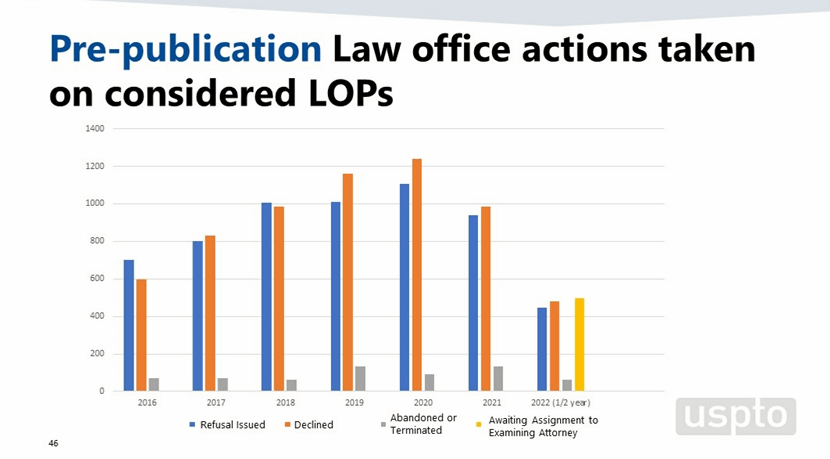
Interestingly, in terms of post-publication LOPs, the results are very different. But it is important to note that the volume of Letters of Protest received post-publication is very low. In 2021, only 38 post-publication Letters of Protest resulted in any action affecting the subject application.
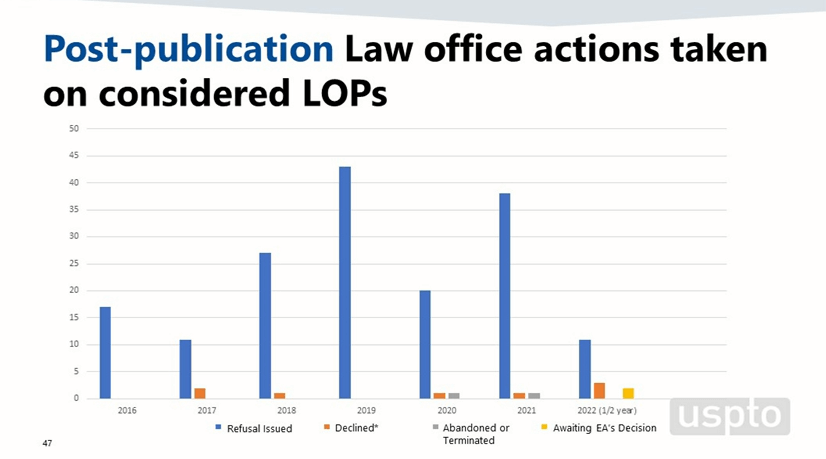
Despite the low levels of success with Letters of Protest, Commissioner Cotton contended that they are still helpful and worthwhile. She noted that Letters of Protest are more helpful post-publication as opposed to pre-publication because as shown on the prior chart, pre-publication Letters of Protest are considered only 50% of the time. The USPTO believes they are getting a lot of pre-emptive Letters of Protest because people want to ensure that the USPTO sees certain evidence. But the USPTO is receiving this information before the mark is even assigned to an examiner. Commissioner Cotton said that it’s a lot of work to file and review a Letter of Protest, and the USPTO is considering whether they need to take action to control the number of pre-publication Letters of Protest being filled. The USPTO is considering moving the date to when you can file a Letter of Protest to be after the application has been assigned to an examiner. The USPTO is also considering whether they need to raise fees for Letters of Protest in order to discourage so many early filings.
Next, Commissioner Cotton discussed other types of petitions that the USPTO is receiving, aside from Letters of Protest. She noted that petitions are climbing over time. Drivers for the rise in petitions include the post-registration audit program, US counsel rule, duplicate registration certificates, COVID-19, as well as the new application and post-registration filing surge. Commissioner Cotton stated that increases in new application filings are directly correlated with increases in new petition filings. Also, Commissioner Cotton pointed out that there has been a 10% increase in post-registration filings which correlates with the increase in petitions. These types of petitions generally relate to specimen refusals in maintenance filings and so forth. Other factors driving the increase in post-registration petitions include the post-registration audit program, duplicate registration certificates, domicile address petitions, and the overall application filing surge.
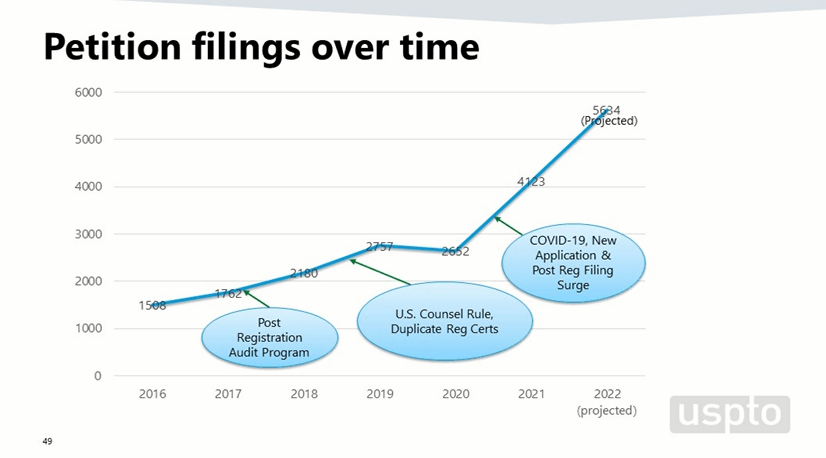
In terms of the types of petitions being filed, Commissioner Cotton said that COVID-19 relief was widely requested earlier on in the pandemic, but that it is not a significant driver any longer. The USPTO is no longer extending the response period for COVID-19 relief and will consider requests of this nature untimely. Commissioner Cotton described other types of petitions that the USPTO is receiving and noted that many other types, unlike COVID-19 relief, will not be going away. These petitions include:
- Post-registration petitions to reinstate and accept late responses
- Post-registration petitions refusal review (for when a specimen is rejected)
- Examination-related petitions
- Last-ditch efforts (“Hail Mary’s” to save applications and registrations)
- Privacy concerns (issues with domicile and owner email addresses)
One petition type that will go away is the petition relating to duplicate registration certificates. Now that the USPTO is issuing electronic registration certificates, this will no longer be an issue. Overall, the USPTO is working to minimize the number of petitions received by making rules clearer, thus reducing the need to request relief.
